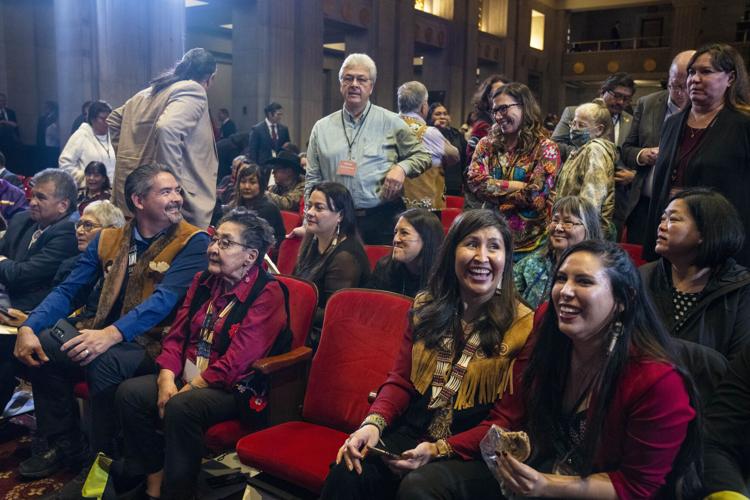TRAVERSE CITY — More than 300 leaders of sovereign nations gathered for The White House Tribal Nations Summit in Washington, D.C.
The two-day, nation-to-nation summit brought together tribal leaders and federal government officials — including President Joe Biden, Vice President Kamala Harris, and Interior Secretary Deb Haaland, citizen of the Pueblo Laguna — to discuss issues important to the progress of tribes.
Leaders from each federally recognized tribe were invited to attend, including several Anishinaabek leaders from Michigan.
First-time attendee and acting Chairman of the Sault Tribe of Chippewa Indians Austin Lowes said the discussions are a great opportunity to build better government-to-government relationships.
“I’m honored to be representing the Sault Tribe,” Lowes said in a statement.
President Joe Biden pledged to give Native Americans a stronger voice in federal affairs, saying that he would foster “respect for Indigenous knowledge and tribal consultations” in government decision-making.
The Biden administration also announced that the Commerce Department will work with tribes to co-manage public resources like water and fisheries. The Agriculture Department and the Interior Department signed 20 co-stewardship agreements with tribes, and another 60 are under review, the administration said.
A new report, being released in conjunction with the summit, will outline best practices on integrating tribal treaty rights, like hunting and fishing on ancestral lands, into the decision-making process for federal agencies.
Biden reiterated a commitment to push for $9.1 billion for the Indian Health Service, which provides healthcare for federally recognized tribes, and make the funding mandatory. It has not been up for a vote in Congress.
Biden’s Treasury Department said it prioritized tribal engagement and feedback in distributing funding from the latest aid package. A report released Wednesday by the administration outlines how tribes spent the money on more than 3,000 projects and services. Native communities across the U.S. spent the money on housing for tribal members, transportation to veterans hospitals, after-school facilities, language and culture programs, emergency services and health care facilities, according to the report.
Vice President Kamala Harris spoke on the Indian Child Welfare Act, a 1978 U.S. federal law currently that governs jurisdiction on the removal of Native American children from their families in adoption and foster care cases, that is currently under Supreme Court review.
The act was crafted to address systemic injustice, Harris said.
“For centuries, Native children were torn away from their families and their communities. These acts were not only violations of basic human rights for those children and their families but also an attack on the very existence of tribal nations.”
U.S. Interior Secretary Deb Haaland said her agency and the federal government were committed to addressing intergenerational trauma in Indian Country.
“This agency, once charged with assimilating our people through family separation, is now leading the work to heal those broken promises and to strengthen Indian Country,” she said.
The Interior Department ensures that Native American children will be able to learn their ancestral languages in schools, Haaland said, by providing access to $13 billion in federal funding through the bipartisan infrastructure bill.
Haaland commented that she was pleased to work with the U.S. Secretary of Education Miguel Cardona to ensure that Native American youth have access to their culture and the preservation of tribal languages.
“Our children deserve to inherit the knowledge our ancestors sought to pass down,” she said.
Haaland added that the Interior Department invested more than $45 billion in Indian Country from the American Rescue Plan, the bipartisan infrastructure law and the Inflation Reduction Act.
Attorney General Merrick Garland from the Department of Justice announced the FBI and the Bureau of Indian Affairs signed an agreement to establish guidelines to provide for the effective and efficient administration of criminal investigations in Indian Country.
It will define responsibilities for FBI, BIA and Tribal investigators to ensure that missing person cases are entered into the National Crime Information Center, National Incident-Based Reporting System and other appropriate federal criminal databases, and that DNA is submitted to the National Missing Person DNA Database when appropriate and available.
This is the first update since the early 1990s to a memorandum of understanding between the agencies. Garland said that the agreement will support the unified response to the Missing and Murdered Indigenous Peoples crisis, and the Missing and Murdered Unit launched by Haaland in 2021.
“Native American families and communities have endured persistently high levels of violence. Women and girls have borne the brunt of that violence,” Garland said in a statement.
According to Garland the DOJ is expanding the Tribal Access Program for National Crime Information, or TAP. This program allows Tribal governments to access, enter, and exchange data with national crime information systems, including those maintained by the FBI.
TAP is now a permanent, required program thanks to the reauthorization of the Violence Against Women Act earlier this year, Garland said.
On Wednesday, federal government officials, cabinet members, and Native leaders participated in panel discussions on education and Native languages, mental health, access to capital and economic development, and climate and clean energy. On Thursday, the summit’s focus was investing in Indian Country, health equity, public safety, and Indigenous knowledge.
Associated Press reporting contributed to this report.






















